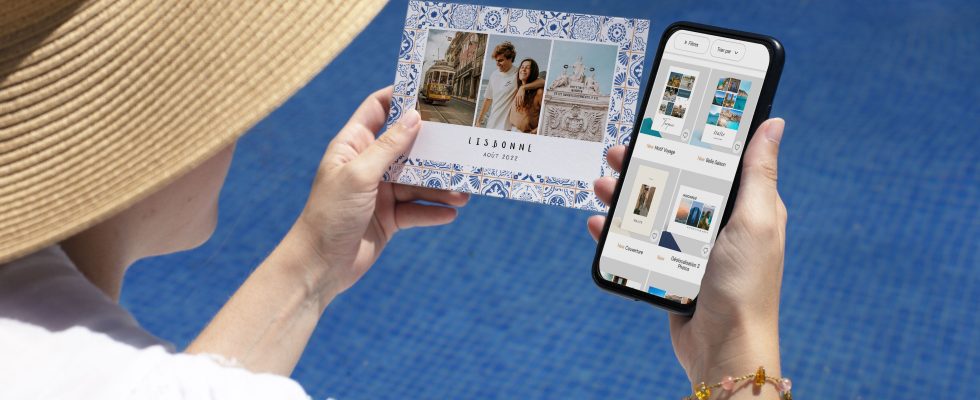No shots of the mountain ranges taken with a drone by a professional photographer, no slightly kitsch sunset, and even fewer shots of shopping streets in the early morning light. To illustrate their holidays in Corsica, Marie’s friends sent her, in the summer of 2019, a personalized postcard with their own photos: the couple posed on horseback, on the beach, in the mountains, in front of natural settings that they actually visited. “It was so much more intimate than a ready-made card! They gave something of themselves, of their own experience… It changes everything”, rejoices the sexagenarian, who even pinned the card for several weeks on her fridge. Summer after summer, she continues to receive this type of mail in her mailbox, from couples of friends or from her children and grandchildren. The retiree is seduced: in turn, she decides to create her own postcard.
“It’s a lot easier than it looks! Just choose our holiday photos on the phone, and the provider then takes care of the printing, postage and dispatch in a matter of minutes. days,” she says. A myriad of applications and sites of all kinds are available to Marie and her husband: over the past ten years, the market has grown considerably in France. So much so that La Poste launched its own personalized postcard service in 2010, renamed Youpix in 2019. Each year, more than two million cards are sent from the application, mainly during the summer and for prices around 2 euros per unit depending on the number of orders. “But we also see peaks at the start of the new school year, at the time of end-of-year greetings… In a society where communication is going digital, we feel that the French remain attached to this practice, if necessary to please with an object concrete that you can hold in your hands”, analyzes Malika Mena-Chelli, marketing director of the digital mail and innovation department of the Post Office.
Cheaper than a classic card
Same feeling on the side of Fizzer, one of the leaders in the sector with more than two million users won over in ten years of existence, and three million personalized postcards sent each year. “When we send news to the people who really matter to us, we want to do more than just a WhatsApp. Customers are looking for that authenticity,” said Claire Palach, marketing director. The interest of the French does not seem to fade over time: this year, the company is showing growth “of around 10%”. For several summers now, Claire, a mother of three, has been using the application to tell her family about her holidays. “There is a fun side: the children choose their photos and dictate their text to me, we share what we really experienced rather than sending a photo which is not the reality of our trip… And in addition, it is a little cheaper than conventional cards,” she argues. While the price of a green stamp now reaches 1.16 euros, Fizzer’s rates are more than attractive for the mother of a family: each shipment will cost her 1.60 euros for the card, envelope and postage. .
“When you’re abroad, it’s also an additional comfort: you don’t have to find the right stamp or the post office at the other end of town,” adds Marianne, who discovered the application during a stay in Australia. Since then, this 27-year-old speech therapist has been conquered: on each trip, she sends her selfies, photos of landscapes and personalized messages to her parents and grandparents, delighted to receive – and to display – such authentic mail. During her last summer visit to her grandfather, the young woman thus discovered the postcard of her skiing holidays displayed prominently in the family living room.
Artificial intelligence and QR codes
“These little attentions are precious: there is a real need to go back to basics and traditions”, comments Mathilde Viana, communication manager of Popcarte – “several million” postcards sold each year since 2005, for an annual growth “d ‘around 20 %”. According to a poll conducted by OpinionWay for the company in July 2021, 79% of French people indicate that the personalized side is the detail that matters most in a postcard, and 74% believe that their own vacation photos would make better shots than those sold commercially. The little piece of cardboard is ultimately not so obsolete: no less than 70% of respondents insist that the postcard is a “tradition to keep”. This does not prevent players in the sector from revisiting it: this year, Popcarte offers, for example, the help of artificial intelligence for holidaymakers in need of inspiration. And for the past two years, a QR code can be added to the user’s text allowing readers to be referred to a video or other photos once the mail has been retrieved.
